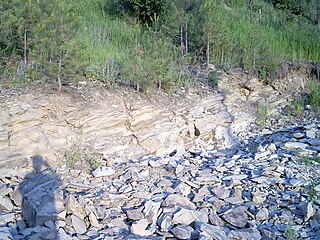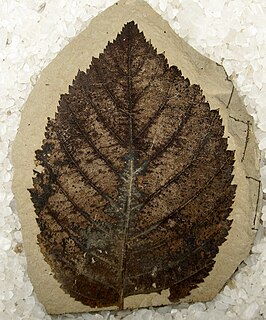Driftwood Canyon Provincial Park is a provincial park in British Columbia, Canada. Driftwood Canyon Provincial Park covers 23 ha of the Bulkley River Valley, on the east side of Driftwood Creek, a tributary of the Bulkley River, 10 km northeast of the town of Smithers. The park is accessible from Driftwood Road from Provincial Highway 16. It was created in 1967 by the donation of the land by the late Gordon Harvey (1913–1976) to protect fossil beds on the east side of Driftwood Creek. The beds were discovered around the beginning of the 20th century. The park lands are part of the asserted traditional territory of the Wet'suwet'en First Nation.

Tilia johnsoni is an extinct species of flowering plant in the family Malvaceae that, as a member of the genus Tilia, is related to modern lindens. The species is known from fossil leaves found in the early Eocene deposits of northern Washington state, United States and a similar aged formation in British Columbia, Canada.

Azolla primaeva is an extinct species of "water fern" in the family Salviniaceae known from Eocene fossils from the Ypresian stage, found in southern British Columbia.
Pinus matthewsii is an extinct species of conifer in the pine family. The species is solely known from the Pliocene sediments exposed at Ch’ijee's Bluff on the Porcupine River near Old Crow, Yukon, Canada.

The Klondike Mountain Formation is an Early Eocene (Ypresian) geological formation located in the northeast central area of Washington state. The formation, named for the type location designated in 1962, Klondike Mountain north of Republic, Washington, is composed of volcanic rocks in the upper unit and volcanics plus lacustrine (lakebed) sedimentation in which a lagerstätte with exceptionally well-preserved plant and insect fossils has been found, along with fossil epithermal hot springs.
Acer stonebergae is an extinct maple species in the family Sapindaceae described from two fossil samaras. The species is solely known from the Early Eocene sediments exposed in northeast Washington state, United States, and the adjacent area of south central British Columbia, Canada. It is one of three species belonging to the extinct section Torada.
Acer toradense is an extinct maple species in the family Sapindaceae described from two fossil samaras. The species is solely known from the Early Eocene sediments exposed in northeast Washington state, United States, and the adjacent area of south central British Columbia, Canada. It is one of three species belonging to the extinct section Torada.
Metasequoia foxii is an extinct redwood species in the family Cupressaceae described from numerous fossils of varying growth stage. The species is solely known from the Paleocene sediments exposed in central Alberta, Canada. It is one of three extinct species belonging to the redwood genus Metasequoia.
Acer stewarti is an extinct maple species in the family Sapindaceae described from a series of fossil leaves and samaras. The species is solely known from the Early Eocene sediments exposed in south central British Columbia, Canada adjacent to northeast Washington state, United States. It is one of only two species belonging to the extinct section Stewarta.
Acer rousei is an extinct maple species in the family Sapindaceae described from a series of isolated fossil samaras. The species is solely known from the Early Eocene sediments exposed in south central British Columbia, Canada adjacent to northeast Washington state in the United States. It is the type species for the extinct monotypic section Rousea.
Acer republicense is an extinct maple species in the family Sapindaceae described from a single fossil samara. The species is solely known from the Early Eocene sediments exposed in northeast Washington state, United States. It is the only species belonging to the extinct section Republica.

The Princeton Chert is a fossil locality in British Columbia, Canada, which comprises an anatomically preserved flora of Eocene Epoch age, with rich species abundance and diversity. It is located in exposures of the Allenby Formation on the east bank of the Similkameen River, 8.5 km (5.3 mi) south of the town of Princeton, British Columbia.

The McAbee Fossil Beds is a Heritage Site that protects an Eocene Epoch fossil locality east of Cache Creek, British Columbia, Canada, just north of and visible from Provincial Highway 97 / the Trans-Canada Highway. The McAbee Fossil Beds, comprising 548.23 hectares, were officially designated a Provincial Heritage Site under British Columbia's Heritage Conservation Act on July 19, 2012. The site is part of an old lake bed which was deposited about 52 million years ago and is internationally recognised for the diversity of plant, insect, and fish fossils found there. Similar fossil beds in Eocene lake sediments, also known for their well preserved plant, insect and fish fossils, are found at Driftwood Canyon Provincial Park near Smithers in northern British Columbia, on the Horsefly River near Quesnel in central British Columbia, and at Republic in Washington, United States. The Princeton Chert fossil beds in southern British Columbia are also Eocene, but primarily preserve an aquatic plant community. A 2016 review of the early Eocene fossil sites from the interior of British Columbia discusses the history of paleobotanical research at McAbee, the Princeton Chert, Driftwood Canyon, and related Eocene fossil sites such as at Republic.

The Allenby formation is a sedimentary rock formation in British Columbia which was deposited during the Ypresian stage of the Early Eocene. It consists of conglomerates, sandstones with interbedded shales and coal. The shales contain an abundance of insect, fish and plant fossils known from 1877 and onward, while the Princeton Chert was first indented in the 1950's and is known from anatomically preserved plants.
Stonebergia is an extinct genus in the rose family, Rosaceae, which contains the single species Stonebergia columbiana. The genus was described from a series of isolated fossil leaves in shale from an early Eocene location in southern British Columbia.

Nuphar carlquistii is an extinct species of flowering plant in the family Nymphaeaceae related to the modern spatterdock, Nuphar advena. The species is known from fossil seeds and fruits found in the early Eocene deposits of northern Washington state, United States, and a similar aged formation in British Columbia, Canada.

Betula leopoldae is an extinct species of birch in the family Betulaceae. The species is known from fossil leaves, catkins, and inflorescences found in the early Eocene deposits of northern Washington state, United States, and similar aged formations in British Columbia, Canada. The species is placed as basal in Betula, either as a stem group species, or an early divergent species.

Pinus latahensis is an extinct species of conifer in the pine family Pinaceae. The species is known from fossil leaves found in the early Eocene deposits of northern Washington state, United States, and southern British Columbia, Canada.

Amia? hesperia is an extinct species of bony fish in the bowfin family, Amiidae. The species is known from fossils found in the early Eocene deposits of northern Washington state in the United States and southeastern British Columbia. The species is one of eight fish species identified in the Okanagan Highlands.








